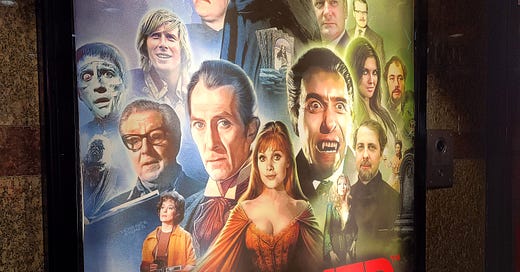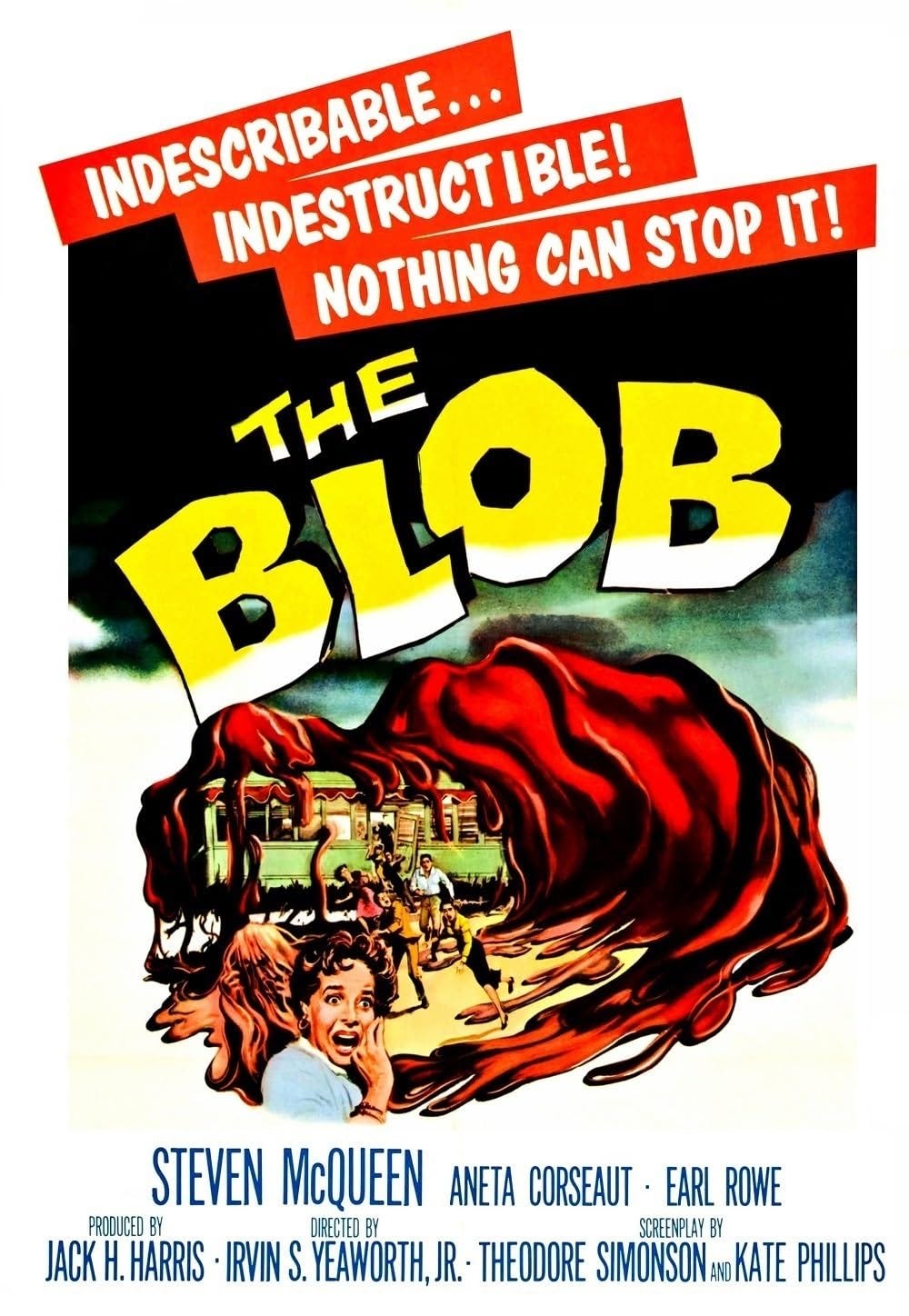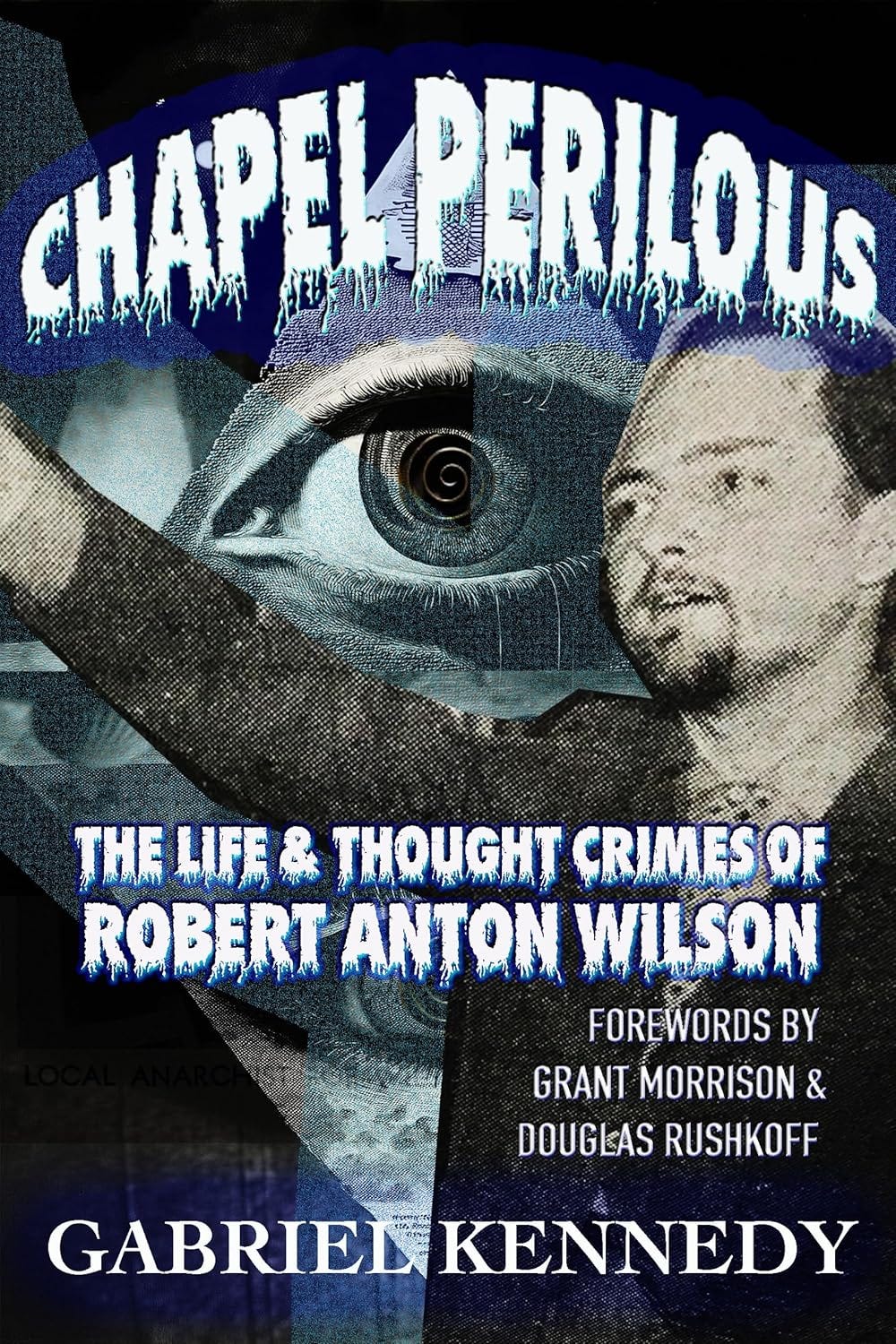Happy Goth Christmas to all who celebrate! Tonight is Hallowe’en, when the monsters will roam.
On Monday I was at the premiere of Hammer: Heroes, Legends and Monsters, a documentary celebrating the 90th anniversary of Hammer Films. This is being broadcast on Sky Arts tonight, and it is a pleasingly geeky deep dive into the studio’s history. The studio has been bought by the perfectly-named John Gore, and is working on “a slate of new films”. This raises the question of how the newly reanimated studio will fare in the twenty-first century - and what type of monsters will resonate now.
You can tell a lot about a time period by the monsters it creates. The uptight repressed Victorians feared the sensuous Count Dracula, threatening to nibble at their untouched necks. Mary Shelley wrote Frankenstein as we entered the Age of Enlightenment, fearing the inhuman horrors that a godless scientific age could create. When those raised in the shadow of World War Two entered the Space Age, their memory of fascism and fears of radiation gave us the Daleks.
So what, exactly, are the monsters of our current hyper-polarised age? At a time when the two political tribes are not only unable to communicate and negotiate, but lack shared accepted definitions about the nature of reality, how would a studio like Hammer create monsters that resonate with everyone?
For one tribe, the monsters are tech billionaires. It’s certainly hard to imagine a billionaire hero being created now, in a similar way to how the twentieth century produced characters like Iron Man and Batman. If a modern story has a billionaire character, you can be certain they will turn out to be a wrong ‘un. Billionaires are the modern expression of a role that has historically been played by feudal barons, slavers, oligarchs, nabobs or factory owners - people who cause immense suffering in order to enrich themselves beyond reason and, perhaps importantly, don’t seem to deserve their riches.
Part of our unease about billionaires, I suspect, comes from our inability to grasp the mind-breaking scale of a billion. While it would take a month to count non-stop up to a million, to count to a billion would take 100 years. A billion is not an amount of wealth that can be earnt honestly through work, and it can only exist through laws designed to allow the accumulations of immense wealth through monopolies or the exploitation of assets. There is something Lovecraftian about a billion - it is unimaginable, unnatural and impossible to truly comprehend without going mad.
If you haven’t done so yet, I’d recommend reading Greg Taylor’s excellent account of the anti-democratic ‘Dark Enlightenment’ philosophies that tech billionaires are currently pushing. This is especially relevant at the moment, given J.D. Vance’s links to this group. What comes across is how emotionally stunted this movement is - the dream of escaping to a world, where no-one can tell them what to do, is the limit of their imagination. They can’t seem to conceive of meaningful relationships. It is all strikingly adolescent.
This is perhaps not surprising, given the isolating effect of immense wealth. When you come from nothing and somebody loves you, there is no doubt that they love you for who you are. For the rich, the question of whether a person would be with them if they didn’t have extreme wealth never really goes away. To spend your life surrounded by people who are only with you because of your money is a terrible fate. I suspect this horror is one reason why billionaires give us the shivers.
And yet, for the other half of society, billionaires are just rich guys you should admire. This can be seen in this recent clip of the BBC presenter Emma Barnett, who appeared shocked to the core by blasphemous criticism of billionaires. It’s also apparent in the support for Donald Trump and Elon Musk (when those two finally turn on each other, incidentally, it will be something).
In those circles, the current monster is not billionaires at all. It is, in Musk’s words, ‘The woke mind virus.’ How can they fight such an alien horror, an expression of victimhood, complaint and condemnation, which lives inside people’s minds like something from a 1950s ‘B’ movie?
To those outside this tribe, of course, this idea is nuts. The woke mind virus is not a real thing, they insist, beyond a general sense that we should treat others decently. Were it not for the extent to which attacks on the woke mind virus emboldens white supremacists and misogynists, belief in it would be extremely funny.
Finding a modern monster, then, is a tricky task in a society so polarised that it has no agreement about what it is we should fear. Half see their problems as caused by the insatiable greed of emotionally stunted man-babies. Others see an oppressive culture that demands forced adherence to an insincere performative morality. The horror is either in our economic structures or in our culture, depending on your tribe. At the heart of this division, I think, is the extent to which we are prepared to think about the feelings of others.
So how can a reanimated studio like Hammer create modern monsters in such polarised times? Perhaps only the story of the inhuman crimes of a woke billionaire will bring people together. So if you’ll excuse me, I’m off to work on a script entitled Taylor Swift Will Kill Again.
Happy Hallowe’en, whatever you fear!
ELSEWHERE
I wrote about the campaign to save William Blake’s cottage in the Big Issue, you can find that here.
I’m delighted to report that the first biography of Robert Anton Wilson has now been published - it’s called CHAPEL PERILOUS: THE LIFE AND THOUGHT-CRIMES OF ROBERT ANTON WILSON, and it’s by Gabriel Kennedy, aka Prop Anon. The hardback and ebook are available now from Amazon, with paperback coming soon. I’m very much looking forward to diving into this.
I’ll be in Newcastle on 1st February next year, as part of New Writing North’s Screenwriting Weekend. I’ll be talking about creativity in writing. Details are here, including information about free bursary tickets - get them while they last. I don’t normally do talks about the process of writing itself, so I’m quite looking forward to this.
Ben Wheatley’s Channel 4 series Generation Z is now streaming and is highly recommended to all, except perhaps dog lovers. For all my earlier talk about monsters representing specific periods, zombies have a unique ability to work on different levels at different times in history. In the early days of social media, for example, not-quite human crowds of brainless people trying to bite and make you like them were all over film and television. This worked on a very different level to the late twentieth century consumerist satires of George A. Romero. Wheatley’s take reimagines the zombie-mythos as a fable of generational inequality - or the demonisation of older people, depending on your perspective. Well worth it just to watch Zombie Anita Dobson living her best life.
Beatles fans, meanwhile, will love Midas Man, the biopic of Brian Epstein now streaming on Amazon Prime. It’s basically a love letter to Brian, which is exactly what he deserves. The portrayal of the Beatles is especially good, providing you can overlook how short John is.
That’s all for now. My next newsletter will arrive on the winter solstice, marking the end the of the first quarter of the twenty-first century. I know! How can that possibly be right? But I’ve double-checked my calendar and it seems to be true.
See you then for a review of the quarter century!
jhx











‘There is something Lovecraftian about a billion.’ I bet you took the morning off after that sentence.
Midas Man is amazing ! Definitely should be called Midi John though .